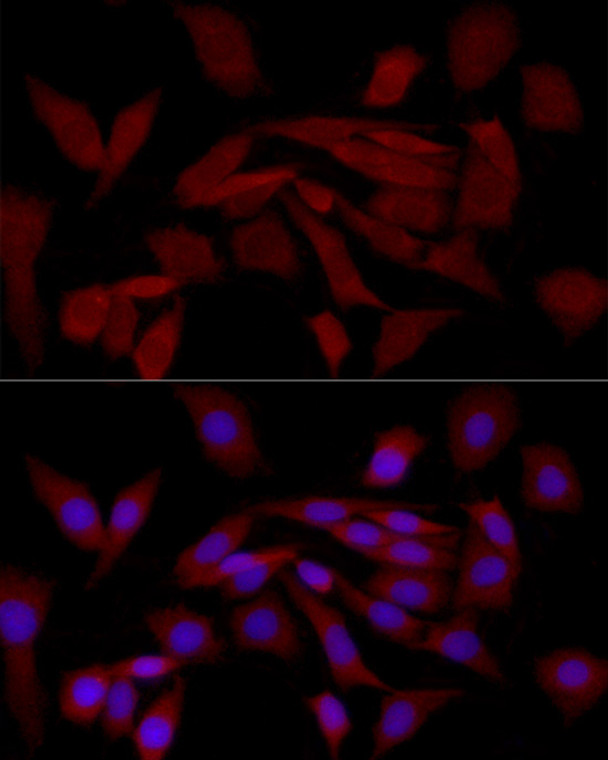| Host: |
Rabbit |
| Applications: |
WB/IHC/IF |
| Reactivity: |
Human/Mouse/Rat |
| Note: |
STRICTLY FOR FURTHER SCIENTIFIC RESEARCH USE ONLY (RUO). MUST NOT TO BE USED IN DIAGNOSTIC OR THERAPEUTIC APPLICATIONS. |
| Short Description: |
Rabbit polyclonal antibody anti-ALOX15 (1-230) is suitable for use in Western Blot, Immunohistochemistry and Immunofluorescence research applications. |
| Clonality: |
Polyclonal |
| Conjugation: |
Unconjugated |
| Isotype: |
IgG |
| Formulation: |
PBS with 0.05% Proclin300, 50% Glycerol, pH7.3. |
| Purification: |
Affinity purification |
| Dilution Range: |
WB 1:500-1:1000IHC-P 1:50-1:200IF/ICC 1:50-1:200 |
| Storage Instruction: |
Store at-20°C for up to 1 year from the date of receipt, and avoid repeat freeze-thaw cycles. |
| Gene Symbol: |
ALOX15 |
| Gene ID: |
246 |
| Uniprot ID: |
LOX15_HUMAN |
| Immunogen Region: |
1-230 |
| Immunogen: |
Recombinant fusion protein containing a sequence corresponding to amino acids 1-230 of human ALOX15 (NP_001131.3). |
| Immunogen Sequence: |
MGLYRIRVSTGASLYAGSNN QVQLWLVGQHGEAALGKRLW PARGKETELKVEVPEYLGPL LFVKLRKRHLLKDDAWFCNW ISVQGPGAGDEVRFPCYRWV EGNGVLSLPEGTGRTVGEDP QGLFQKHREEELEERRKLYR WGNWKDGLILNMAGAKLYDL PVDERFLEDKRVDFEVSLAK GLADLAIKDSLNVLTCWKDL DDFNRIFWCGQSKLAERVRD SWKEDALFGY |
| Tissue Specificity | Detected in monocytes and eosinophils (at protein level). Expressed in airway epithelial cells. |
| Function | Non-heme iron-containing dioxygenase that catalyzes the stereo-specific peroxidation of free and esterified polyunsaturated fatty acids generating a spectrum of bioactive lipid mediators. It inserts peroxyl groups at C12 or C15 of arachidonate ((5Z,8Z,11Z,14Z)-eicosatetraenoate) producing both 12-hydroperoxyeicosatetraenoate/12-HPETE and 15-hydroperoxyeicosatetraenoate/15-HPETE. It may then act on 12-HPETE to produce hepoxilins, which may show pro-inflammatory properties. Can also peroxidize linoleate ((9Z,12Z)-octadecadienoate) to 13-hydroperoxyoctadecadienoate/13-HPODE. May participate in the sequential oxidations of DHA ((4Z,7Z,10Z,13Z,16Z,19Z)-docosahexaenoate) to generate specialized pro-resolving mediators (SPMs)like resolvin D5 ((7S,17S)-diHPDHA) and (7S,14S)-diHPDHA, that actively down-regulate the immune response and have anti-aggregation properties with platelets. Can convert epoxy fatty acids to hydroperoxy-epoxides derivatives followed by an intramolecular nucleophilic substitution leading to the formation of monocyclic endoperoxides. Plays an important role during the maintenance of self-tolerance by peroxidizing membrane-bound phosphatidylethanolamine which can then signal the sorting process for clearance of apoptotic cells during inflammation and prevent an autoimmune response. In addition to its role in the immune and inflammatory responses, this enzyme may play a role in epithelial wound healing in the cornea through production of lipoxin A4 (LXA(4)) and docosahexaenoic acid-derived neuroprotectin D1 (NPD1.10R,17S-HDHA), both lipid autacoids exhibit anti-inflammatory and neuroprotective properties. Furthermore, it may regulate actin polymerization which is crucial for several biological processes such as the phagocytosis of apoptotic cells. It is also implicated in the generation of endogenous ligands for peroxisome proliferator activated receptor (PPAR-gamma), hence modulating macrophage development and function. It may also exert a negative effect on skeletal development by regulating bone mass through this pathway. As well as participates in ER stress and downstream inflammation in adipocytes, pancreatic islets, and liver. Finally, it is also involved in the cellular response to IL13/interleukin-13. |
| Protein Name | Polyunsaturated Fatty Acid Lipoxygenase Alox1512/15-LipoxygenaseArachidonate 12-Lipoxygenase - Leukocyte-Type12-LoxArachidonate 15-Lipoxygenase15-Lox15-Lox-1Arachidonate Omega-6 LipoxygenaseHepoxilin A3 Synthase Alox15Linoleate 13s-Lipoxygenase |
| Database Links | Reactome: R-HSA-2142691Reactome: R-HSA-2142712Reactome: R-HSA-2142770Reactome: R-HSA-6785807Reactome: R-HSA-9018677Reactome: R-HSA-9018681Reactome: R-HSA-9018896Reactome: R-HSA-9023661Reactome: R-HSA-9025106Reactome: R-HSA-9026286 |
| Cellular Localisation | CytoplasmCytosolCell MembranePeripheral Membrane ProteinLipid DropletPredominantly CytosolicBecomes Enriched At Membranes Upon Calcium BindingTranslocates From The Cytosol To The Plasma Membrane When Stimulated By Il13/Interleukin-13 And In Macrophages Binding Apoptotic Cells |
| Alternative Antibody Names | Anti-Polyunsaturated Fatty Acid Lipoxygenase Alox15 antibodyAnti-12/15-Lipoxygenase antibodyAnti-Arachidonate 12-Lipoxygenase - Leukocyte-Type antibodyAnti-12-Lox antibodyAnti-Arachidonate 15-Lipoxygenase antibodyAnti-15-Lox antibodyAnti-15-Lox-1 antibodyAnti-Arachidonate Omega-6 Lipoxygenase antibodyAnti-Hepoxilin A3 Synthase Alox15 antibodyAnti-Linoleate 13s-Lipoxygenase antibodyAnti-ALOX15 antibodyAnti-LOG15 antibody |
Information sourced from Uniprot.org
12 months for antibodies. 6 months for ELISA Kits. Please see website T&Cs for further guidance









